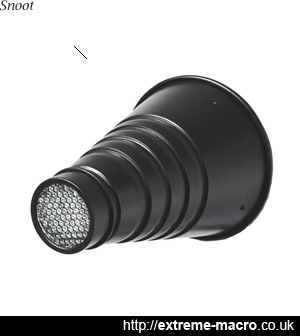Flash Snoot
by Johan J Ingles-Le Nobel
Last updated August 31, 2017
A snoot is a tube or similar object that fits over flash and allows the photographer to control the direction and radius of the light beam.
Snoots may be conical, cylindrical, or rectangular in shape. Snoots isolate a subject when using a flash, and further help by stopping light spill, ie when lighting falls in a larger footprint than intended.

Pringles tubes, much beloved in the macro community as a tasty way to make a snoot. Making your own snoot to focus light for you couldn't be any easier. An A4 sized piece of foam rubber made into a cylinder with tough sticky plumbing tape and you're done. Line it with kitchen foil inside to make it reflect more light. A snoot can be made from paper, foam sheets, corrugated plastic, a cereal packet... or pringles.
Field Macro Use
I use a snoot for field macro to concentrate light on the specimen. A fresnel might achieve a similar result but with a fresnel there is a danger of bright sunlight melting your flash if you point it towards the sun accidentally for a prolonged period of time. This really happens.
Snoot Light Gain?
An efficient snoot may gain you light, because if the internal surface is reflective, it reuses light that would normally be wasted. A flash set to disperse its light out over 45 degrees with a foot long snoot gives more light at a spot 6 inches in front of the snoot than a snootless flash.
Flash Zoom or Snoot?
You might be tempted to think that zooming your flash to say 105mm would do much the same as a snoot, but in fact the effect is still quite different. Snoots are much more binary than flash zooms and the light falloff at the edge is much more dramatic. Snoots literally allow spotlighting of one part of your scene without any light falling onto other parts of your scene but you'd be hard pressed to achieve this with a zoomed flash. That said, when you increase the zoom of your flash you also increase its Guide Number (GN) as well because the light is concentrated in a smaller area. Thats something which snoots do far less, but can be useful to obtain a greater output with a flash unit if you're in a bit of a lighting pickle.
Making a Snoot

Studio snoot with a honeycomb grid over the end to only let parallel light out. Snoots are often used in fashion and portrait photography to create a very dramatic spot of light on a face against a relatively dark background.
Making a flash snoot couldn't be any easier. An A4 sized piece of foam rubber made into a cylinder with tough sticky plumbing tape and you're done. Line it with kitchen foil inside to make it reflect more light. A snoot can be made from paper, foam sheets, corrugated plastic or even from a cereal packet.
With a snoot, longer the tube the tighter the beam of light. For an even tighter beam, use straws inside your snoot (which actually makes it into a grid). The colour inside of a snoot determines how quickly the edges of the light fall off. If the interior is black, you get fast fall off and sharp light edges; if it is white, you get softer edges while silver produces even softer edges again.
Snoots can just as well be use on small Ikea lamps used as continuous lighting to tighten the beam even further or to provide more precise light positioning on a diffuser. Blackened foil makes an excellent little Jansjo snoot as it can be shaped round the bulb enclosure very easily.
Related Articles

Borrowing studio lighting techniques from product, fashion and portrait photography to add sparkle to extreme macro photography



